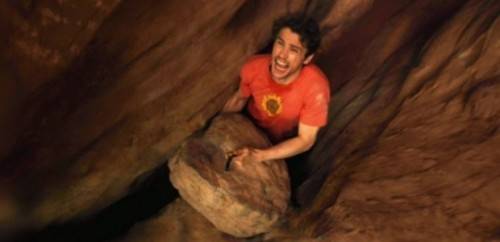Previews:
The Girl Who Kicked the Hornet’s Nest
In which our intrepid journalist, hacker extraordinaire, and revealer of well-kept secrets is brought to heel by the global empire for attempting to hold Power accountable and disrupting business as usual. Wait . . .
The Main Event:
Danny Boyle’s latest feature, 127 Hours, begins with the propulsive rhythm of millions of people and vehicles racing at hyper speed along the concrete ways of some unidentifiable urban center. Perhaps a strange opening for a film about a man who falls into a canyon, is trapped under a boulder, and eventually cuts his own arm off in order to escape, but ultimately, it makes sense.
This is the world that Aron Ralston, played with exuberance and intensity by James Franco, is doing his best to escape during the initial credits. He races through and past the teeming throngs, the cars, the fast food, the brands and logos and consumer goods, and all other manner of early 21st-century mass society on his way out to the desolate, unspeakably beautiful Canyonlands, one of the last vestiges of the Great American Western Wilderness.
Of course, being a high-flying, adrenaline-pumping, backcountry superhero, Ralston fails to tell anyone where he is going. This turns out to be a pretty big problem when some loose rocks give way while he is canyoneering, and he ends up trapped under the piece of earth that will force him to confront himself, physically, emotionally, existentially.
 Some outdoor enthusiasts and wilderness seekers were critical of the behavior that led the real-life Ralston into his desperate predicament. He was careless and stupid for going out alone and not informing anyone of his expected whereabouts, and he paid the price for that. That he went on to write a book (from which this film was created) and became something of a hero for just such recklessness is all the more galling.
Some outdoor enthusiasts and wilderness seekers were critical of the behavior that led the real-life Ralston into his desperate predicament. He was careless and stupid for going out alone and not informing anyone of his expected whereabouts, and he paid the price for that. That he went on to write a book (from which this film was created) and became something of a hero for just such recklessness is all the more galling.
Those criticisms may be right on, and neither Boyle nor the on-screen Ralston flinch from recognizing this egregious mistake as more than a mistake, but rather the culmination and product of Ralston’s choices in the world away from the Canyon—his desire to be alone. But Boyle is nuanced enough to be honest without being judgmental. And anyway, once trapped, the critical sneers fall by the wayside as man and audience feel the biological panic of the situation.
This story would almost seem to be unfilmable, but Boyle pulls it off with no small help from a James Franco that you get to know intimately over the course of the 94 minutes of run-time. The stark beauty of the desert doesn’t hurt either. There are a few cutaways, as Ralston recalls past events, imagines himself anywhere else, and begins to hallucinate as his body deteriorates. These sections give clues as to Ralston’s joys and regrets. But mostly, the action takes place in a small confined place, propelled by the facial expressions of Franco, and his interactions with the video camera he brought along on the adventure.

Small things grow large in the enclosed space of the canyon and the camera. Little humors seem desperately important against the weight of the situation. Triumphs are redefined as little feats of engineering to retrieve a knife or keep warm against the 50 degree temperature swings of the desert. Supporting characters are ants and ravens. 100 mL of water.
When the act of emancipation finally comes, it is with a sense of relief as much as horror and disgust. It’s gruesome, yes, but in just under an hour and a half, you’ve lived through enough agony to make this look much more than necessary. And you’re ready, with Ralston, to return to the world of people and things. Having reexamined life and its relationships, ready to sacrifice a piece of the self for a new chance at that life.
127 Hours is currently playing at The Art.








